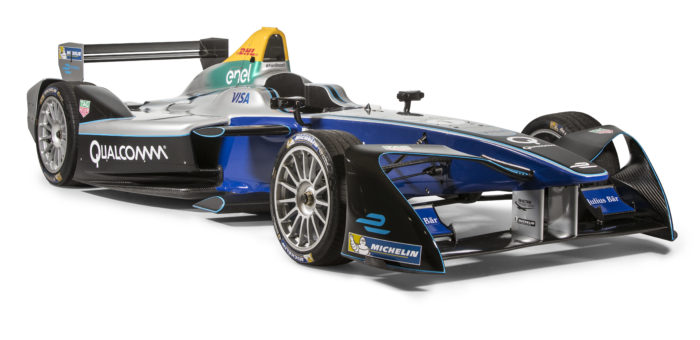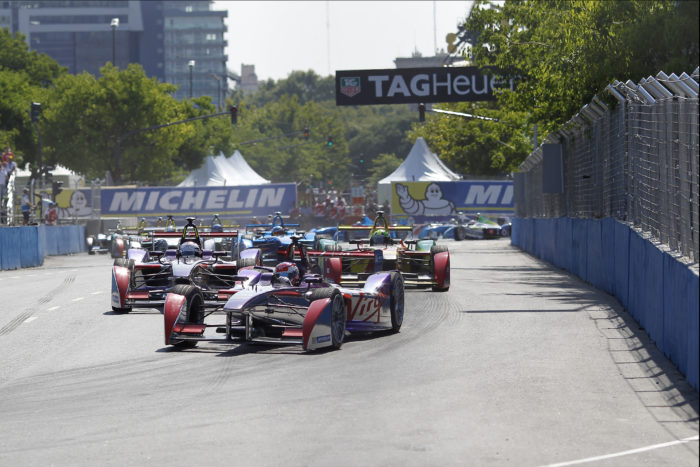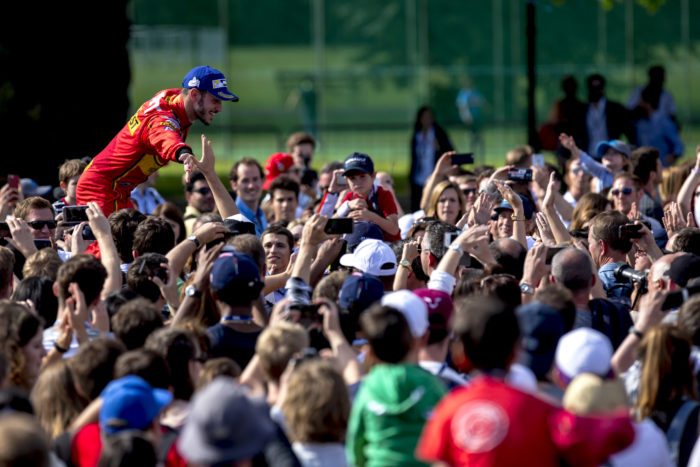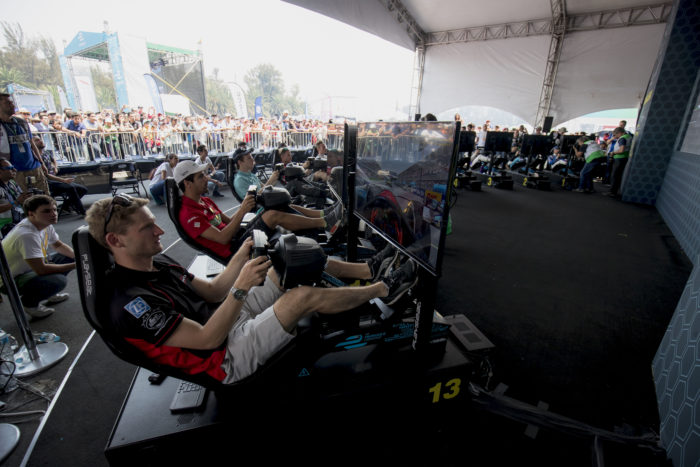How Cars Like This Will Be Doing 140 mph in Brooklyn
Formula E racing comes to Red Hook this weekend, aiming to thrill spectators with technology and speed
A Formula E car can go from 0 to 60 mph in about three seconds (Photo by Malcolm Griffiths/LAT/Formula E)
Brooklyn has a little bit of almost everything, but auto racing is not one of the things that comes to mind as a primary Brooklyn pastime. (Drivers flying down Atlantic Avenue at 60 mph doesn’t count.) The lack of a racetrack and the fact that many residents don’t even own a car would seem to argue against the borough being a suitable setting for a racing circuit. This logic would be flawed, however.
The organizers of Formula E, the electric-car counterpart to Formula One, are counting on the underlying cool factors of their event to drum up enthusiasm for their ePrix race this weekend in Red Hook. They’re betting on the interest of Brooklynites in sustainable energy (check), emerging technology (check), and a love of design (check) to bring the curious into the stands. Not to mention the sight of traffic that really moves.
The Formula E circuit, which launched in 2014, races cars primarily on temporary tracks rather than conventional race courses. The cars look nothing like a Chevy Spark or even a Tesla Model S. Formula E cars are seriously aerodynamic machines, resembling Indy cars and Formula One racers. Powered by electric motors with at least 250 hp, they can go from 0-60 mph in just three seconds and reach speeds of 140 mph on their tightly curved courses. They only thing missing is the roar of the engines; a spokesperson for Formula E compared the sound of the cars to “really loud vacuum cleaners.”

At a Formula E race in Buenos Aires, cars navigate a hairpin turn (Photo by Adam Warner/ LAT/FE)
How did Formula E select Brooklyn? The circuit’s founder CEO, Alejandro Agag, approached former Mayor Bloomberg’s administration several years ago while lining up sites for his new creation. Part of the draw of the races would be that they would occur right in the heart of world-class cities. The most recognizable buildings and streets in London, Moscow, Beijing, Buenos Aires, and other iconic urban centers would be the backdrop for the futuristic, single-seat electric cars as they navigated a 1.2 mile course on city streets.
“Trying to find a 1.2 mile track in New York City … it was a short list [of venues],” said Mike Hopper, who at the time was a vice president for NYC & Co., the city’s marketing and tourism agency. A location showcasing the city was key to creating interest both locally and internationally. Enter Red Hook.

Getting a charge from the fans at a Formula E championship in London (Photo by Zak Mauger/LAT/Formula E)
The Brooklyn Cruise Terminal and surrounding area was eventually selected as the race location, based on its vast parking lot and spectacular views. This took the cooperation of the Port Authority of New York and New Jersey (which owns the property) and the New York City Economic Development Corp. (which leases it), as well several local contractors who could turn the area into a racetrack without permanently altering the area.
One of those local contractors was West Nyack-based McLaren Engineering Group, which was chosen partly because of its work on the boats and docks for the new NYC Ferry system. McLaren (no relation to McLaren Automotive, which designed the motors for the cars) had recently installed a landing at the Atlantic Basin, which sits at the edge of the proposed track. This provided a strong working relationship with the Port Authority and NYCEDC.
The challenge was to convert a cruise-line terminal into a race course with room for as many as 20,000 spectators. Steven Grogg, McLaren’s civil/site design chief, said that the firm worked with Formula E to remove conflicting elements like signs and curbs, while building grandstands and other facilities that can be quickly removed, all the while allowing nearby companies to keep their operations rolling.

In the eVillage, fans will be able to test their driving skills on simulators like these at a Mexico City race (Photo by Zak Mauger/LAT/Formula E)
Hopper believed that the Red Hook community would be supportive, given its DIY spirit. Coincidentally, Tesla has one of its electric-car dealerships practically next door to the planned race. “When we looked at the site and Red Hook community, it lines up well with our sustainability,” Hopper said. “Red Hook is a maker-community. They are constructing. That aligns with Formula E.”
The Fan Experience
While a Formula E race is just 50 minutes long, the race organizers plan full days of entertainment for fans, starting with practice laps in the early morning. In the nearby Allianz eVillage, spectators can browse among exhibits showing off e-car technology, meet the drivers, test their driving skills on racing simulators, and visit food-and-beverage vendors. Tickets are priced at $85 for one day and $150 for the two-day series, with lower prices for students and kids. There will be no parking available for patrons–in fact, they’re strongly discouraged from driving to the event–but other transportation choices are available.
Take a spin around the Brooklyn track with Victor Cruz (Video courtesy of Formula E)
Culturally, Brooklyn is a good fit for a car race based on sustainability, since it’s home to quite a few green companies, including Brooklyn SolarWorks, Gotham Greens, and Radiator Labs. The racing circuit is not just for fun; it’s also about business research. Formula E racing allows companies like Renault, Audi, and Jaguar to test new batteries and other components that eventually will be applied to consumer vehicles. The thinking is that as these innovations are tested and proven, regulations (specifically around batteries) can evolve to allow the acceleration of commercial sales. For example, in the current racing format each driver must have two cars, swapped during a mandatory pit stop, since a single battery can’t hold enough charge to last the full race. Formula E is projecting that by season five (2018-19) they will need only one car per driver for the duration of the race.
“Motorsport has always been a laboratory for the development of technology in the motor industry,” Agag said in a statement. “This just goes to show the relevance of Formula E as a platform to enhance alternative-energy solutions.” Gentlemen, start your vacuum cleaners!













